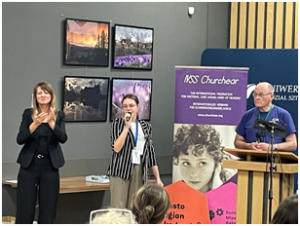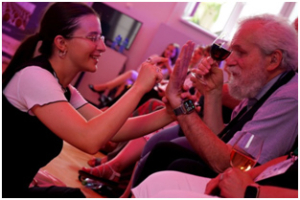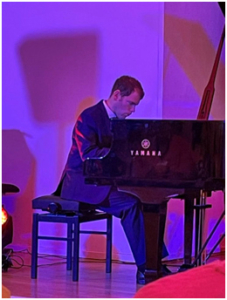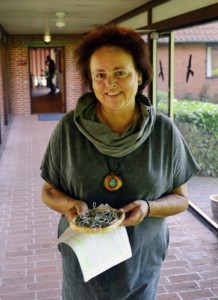The search for one’s own identity
– connecting the world of silence with the world of sound
By Barbara Adamus, deacon of the Evangelical-Augsburgian Church in Poland, board member of IVSS Churchear
(Click for a German version of this article)
People with hearing problems are among us. They form a world of their own, to which hearing people cannot always find their way, even if they want to. They are our sisters and brothers in Christ and want to be treated as such. Can art serve to support and communicate with each other?
The number of people with hearing problems is increasing rapidly. People with hearing impairment, deafness, deafblindness… Not everyone is aware that this is the most numerous and at the same time most overlooked group of disabled people. Even within the family, a person with a hearing impairment is often overlooked and their need to participate in the lives of their loved ones is disregarded.
IVSS Churchear, the International Federation for Pastoral Care among Hard of Hearing, aims to raise awareness of the need for people with hearing impairments to participate in normal social life, including church parish life, that they want to hear the gospel and not be treated as disabled people, but as full community members, sisters and brothers in Jesus! It already seems to be the norm that public buildings must be accessible to people with reduced mobility. What is often forgotten, however – even by churches! – is accessibility for people with hearing problems.
The last meeting of the European Erasmus+ project work group took place from June 7th to 10th 2024. Our work meeting began with the one-day Fifth International Conference of the University of Silesia in Katowice at the Cieszyn branch with the theme: Art, creativity and creativity in the lives of people with hearing impairment. This conference highlighted the importance of art, its perception and creation as a form of therapy, support and rehabilitation, as well as a good tool for communication between the world of the hearing impaired and the hearing world.
Deaf artists create special art for our time
Deaf artists create special art for our time. The theme of her works is the lack of understanding among those who are hearing, alienation, the search for one’s own identity – e.g. a painting in strong primary colours, the frequent motif of which is the large hands, being used in communication – sign language. Ein bekannter The late Albert Fischer was a representative of this trend in Germany. The most famous representative, however, is the American Nancy Rourke, a pioneer of Deaf Art, who deals with the discrimination of deaf people in her works. Her most famous painting is Koda (Kids of Deaf Adults) – a hearing child waiting for its deaf, signing parents.
Another well-known representative of the movement is Susan Dupor, another American. Her painting Family Dog shows a deaf girl lying on the floor, hearing her family talking – the blurred faces suggest that the child has no understanding of language.
Let us look back at our (i.e. Polish, translator’s remark) history. At the court of King Stanislaw August, deaf artists were employed in the studio of his court painter Marcello Bacciarelli. In 1817 an institute for the deaf was founded in Krakow. Here, deaf children could develop their artistic skills in their own environment. A Roman Catholic priest took care of children with special artistic talent and sent them to the Academy of Fine Arts. Currently there is a group of about 40 affiliated deaf artists in our country. From the speeches of the lecturers and from the works of the children and adult artists, it was clear that the culture of people with hearing problems is simply of a different quality. It cannot be linked to any disability or illness.
Signed poetry and film
Arkadiusz Bazak, actor, director, musician and cameraman, presented sign poetry at the conference. “Every language has its own way of expressing beauty. These can be rhymes, subtle wordplay that works with associations. I’m signing. In the sign language that I use every day and in which I write poems, the rhyme is the rhythm of the blink, the shape of the hand, the use of space. These possibilities are truly diverse,” he explains.
Professor Magdalena Zdrodowska from the Jagiellonian University introduced the conference participants to the world of deaf cinema. The first screening of this cinema took place in 1901-1902, when the American anthem was shown against the backdrop of the American flag. The real beginning, however, was the visionary project of the American Deaf Association, in which deaf actors appeared in front of the camera. The Polish Deaf Cinema was linked to the Polish Deaf Association and its main centre in Szczecin, where a two-week film workshop with camera handling and script writing took place every year from 1996 to 2006.
Michal Justycki from the Silesian Museum, co-founder of the Deaf Artists’ Group, spoke about the Dictionary of Art in Sign Languages. Together with Dagmara Stanosz, he is also the creator of the largest European exhibition on deafness at the Silesian Museum in Katowice, focusing on accessibility, communication and culture.
Hearing is like putting together a jig-saw puzzle
A hearing-impaired person hears differently, even if they wear a hearing aid or have an implant. Their hearing can be compared to putting together a jig-saw puzzle. Frequently not all parts of a sentence are captured, so it is important that we offer our interlocutor the best possible conditions. Our face must not be in shadow, our lips must be clearly visible, and we must speak slowly and very clearly. The body language is higly important as well. Communicating by sign language must not be done with a stony expression, but must reflect emotions.
The most important, however, is to show that you are interested in your conversation partner. With admiration have I watched the work of two assistants to the deaf and blind Grzegorz Kozłowski, the President of the Polish Association for the Hearing Impaired. They communicate with him using the Lorm alphabet – in which each letter is assigned a corresponding point on the palm of the hand – although he has been able to perceive clear speech since he got his Cochlear Implant. He and his colleagues were the first to launch a live subtitling project for the hearing impaired (i.e. in Poland, translator’s remark). Raising awareness of the need for universal accessibility for people with hearing and visual impairments is a priority. The lecturer, together with his assistant Anna Nawrot, presented aids and understanding for the hearing impaired.
Deaf in the Church
Last year Father Pawel Kasprzak became the first deaf priest of the Roman Catholic Church. Father Pawel, who has been deaf since birth, uses both spoken language (while studying he founded the organisation Deaf Speaking) , reading speech from lips, and sign language. He studied two subjects – theology and special education. Within one year he wrote and defended two master’s theses. His ordination took place in the cathedral of Katowice, which has the most miserable acoustics. However, a sign language interpreter was present and the cathedral was equipped with an induction loop and live captioning. Confessing in a confessional is impossible for him; he therefore confesses in the parish hall. He had, however, a difficult start – he was, being a deaf person, not intended to become a priest.
Goo acoustics are, of couse, important. Then there are the induction loops (hearing assisting equipment) – how many of our churches and community centers have such ones? – even though loops should compulsory, like for example wheelchair ramps. We cannot talk about inclusion, about removing barriers between the worlds of the hearing and the hearing impaired, without these so affordable and necessary tools.
Accompanying events included a performance by drummers from the Special School and the Educational Centre for the Deaf and Hard of Hearing in Racibórz, an exhibition of children’s artworks and an exhibition of graphics and photographs by various authors.
 The conference concluded with a concert of film music performed by the Silent Choir of the University of Silesia and a piano recital entitled “I Hear the Light of the Moon” by Grzegorz Płonka. Until he was 14, the pianist was treated as a mentally handicapped child, being suspected of suffering from profound autism. The truth was different. He had hearing problems after suffering from cerebral palsy. His life story was the basis for the film Sonata, showing his adoptive mother’s struggle for his health and the discovery of his immense musical talent (his biological mother was a pianist). He tells of himself that his first language was music. Having got a Cochlear Implant he can now hear, speech, however, is worse.
The conference concluded with a concert of film music performed by the Silent Choir of the University of Silesia and a piano recital entitled “I Hear the Light of the Moon” by Grzegorz Płonka. Until he was 14, the pianist was treated as a mentally handicapped child, being suspected of suffering from profound autism. The truth was different. He had hearing problems after suffering from cerebral palsy. His life story was the basis for the film Sonata, showing his adoptive mother’s struggle for his health and the discovery of his immense musical talent (his biological mother was a pianist). He tells of himself that his first language was music. Having got a Cochlear Implant he can now hear, speech, however, is worse.
When he began to hear, he taught himself to play part of Beethoven’s – who also was hearing impaired – Moonlight Sonata, which enabled him to attend music school and boosted his performances. Since he won the 1st International Music Festival for hearing-impaired children, young people and adults “Snail rhythms” in 2015, he has been called the “Beethoven from Murzasichl” and the “Nikifor of the piano”.
The deaf and the hard of hearing are among us. In their family, in their social environment they often ask themselves: Who am I? What identity do I have? Where do I fit in? The problem of self-identification and identity was highlighted by the journalist Dominika Kopanska, saying: “For the deaf, I am too hearing and for the hearing, I am too deaf.”
The risk of hearing loss or hearing deterioration concerns all of us. So maybe it’s worth getting familiar with the issue; maybe it’s worth considering how I can help? How can I do my part to connect the world of silence with the world of sound?

